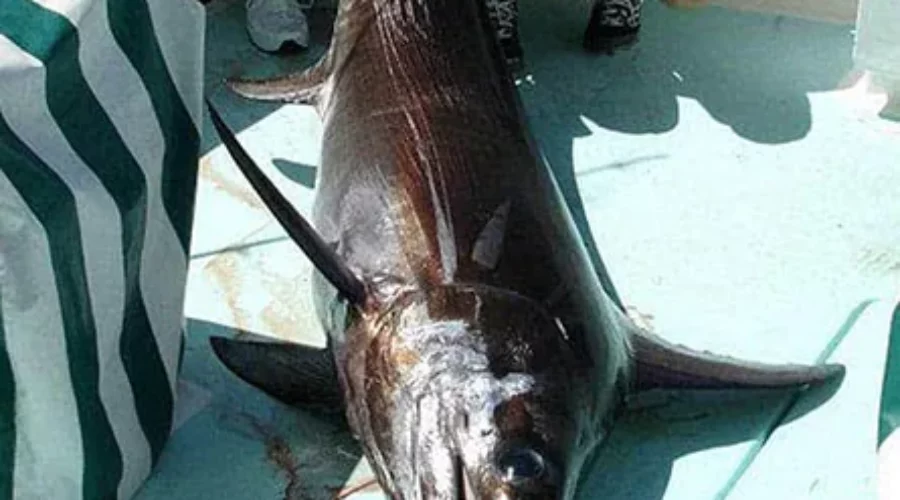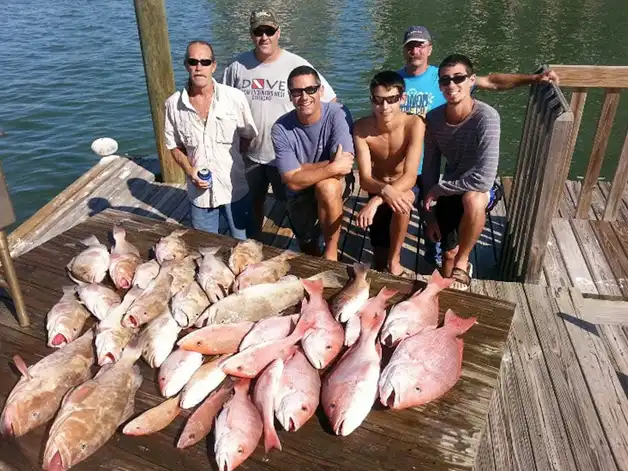A Beginner’s Guide to Swordfishing Day and Night
Swordfish are one of the largest of the world’s billfish and can reach a maximum size of 15 ft. and a weight of 1,400 pounds. They have a long, the longest of all billfish, snout or spear. However, unlike Marlin and Sailfish, which have sharp protruding snouts, the Swordfish snout is flat, and its edges are sharp like a knife. For this reason, they are often called Broadbill. Swordfish and all billfish do not spear their prey. They slash and stun it. In the case of the Swordfish, it has to cut the fish in pieces because, as adults, they do not have teeth.
Swordfish are one of the quickest fish in the sea, reaching a speed burst of 60 miles per hour. There are only a few fish quicker in the oceans. They attain this speed due to their streamlined body and powerful tail. Swordfish are found in most oceans; Pacific, Atlantic, Indian and many seas, including the Mediterranean and Caribbean. Pacific Swordfish tend to be the largest, while Mediterranean Swordfish are the smallest. But all of them are large, and a real challenge to bring one into the boat.
Swordfish are diurnal, which means they are active both day and night. During the day, you will find them cruising in deep water up to 1800 ft. in depth, but they can go as deep as 10,000 ft. deep. At night they rise to 300 ft. or even less as they come up from the depth, searching for food.
They are opportunistic in that they eat whatever comes their way. They are one of the tops in the food chain in the ocean, with only large Sharks, Killer Whales and Humans a real threat. Their diet as adult swordfish consists of pelagic fish, larger as they get larger, including Tuna, Bonito, Mackerel, Hake, squid and octopus.
There are two ways to fish for Swordfish; Daytime deep dropping to depths as deep as 1500 ft down, and Nighttime you do not go deep because the Swordfish come closer to the surface to feed, so you need hooks no deeper than 200- 300 ft. attached to balloons to alert of a strike.
For daytime Swordfish fishing, you will need special equipment to get them to bite. I mean a lot of equipment. You need a really good electric reel, which is critical, especially if you are fighting a monster 1000 feet deep. An excellent idea is to get one that has an interchangeable spool because being able to change spools is invaluable.
Along with the reel, you need a rod built for swordfishing with a soft tip and a good backbone. You need a braided line because that will give you a very strong line that is thin enough with a narrow diameter and impressive breaking strength. A 65 lb. can be used, but an 80 lb. line is probably better.
So now you have the basics. It is time now to purchase all of the tackle to make your trip fruitful. You will need a braided line. It has a narrower diameter, making it easy to cut through the water, making fishing at great depths much easier. It also has excellent breaking strength. You should also have a wind on a long leader, 150 ft. long or more.
You will need a ball bearing swivel at least 300 lbs in weight, and a 300 lbs. leader crimped securely (note you can spend a little more for 250 lbs fluorocarbon). You will also need 8/10/12 lbs. lead weights with longline clips to remove the lead as quickly as possible when fighting a fish and 9/0, 10/0 or 11/0 J-hooks. Diamond-shaped water-activated lights ( they can be blue or green or white or a combination) are also essential in pursuing one of these giants.
You need to bring the Swordfish up to the boat, but you still need some equipment to bring it onto the boat. First, you need two 8 -12 ft. heavy aluminum harpoons with stainless-steel darts and at least 1,000 ft. of line attached. Then you also need at least two 8 ft. gaffs with a 4 or 5-inch hook to bring it to the side and ultimately into the boat and rope to secure it to the boat. Of course, you also need a good boat that is equipped with the latest navigation and fish finding equipment with a fighting chair and harness. This is all very expensive, very expensive to the tune of $80,000+. And two more expenses you have to factor in are the boat’s maintenance and the equipment and fuel.
Nighttime fishing is similar in that you need all of the equipment you need for daytime fishing, but with a few big differences. During deep-dropping, you can only fish one line at a time, whereas at night, you can fish from multiple reels. The reels at night can be electric, but some fishermen prefer to feel and experience the fight on a regular rod and reel. You still need the leaders, weights etc., but for weights much less, between a 12 oz and 32 oz, as at night, the Swordfish come up from the depths to feed, so you only need to drop your lines 100 ft. – 300 ft. or so, rather than 1200 ft. during the day.
You still need a lot of line because the fish will either dive deep or jump up in the air after the hook is set. The line will be attached to balloons to show a strike. Also, lights of different colors are attached to the lines and shined from the boat. Swordfish and other fish are very attracted to the lights at night. Two other main differences between day and night fishing are the techniques used. In the daytime, you use a deep drop method, while at night, you do trolling. Also, the fish brought into the boats during the day are usually larger than the nighttime fish. Getting fish over 200 lb. range is more of a regular occurrence during the day while it is not frequently achieved at night.
At least for the beginning, the better choice is to go with one of the many experienced professional Swordfish charters located in marinas worldwide. They have all of the equipment you need, the experience to know where to go to put you on the fish, how to rig your lines and how to get the fish into the boat. If you did this independently, you would probably lose one or more fish while learning the ins and outs.
Going on a charter, you can learn from the best and then decide if it is worth investing it or just using that money to keep going out on a Swordfishing charter.



